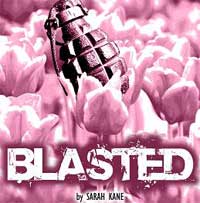
Folino and Garrigan make SWEENEY TODD an audience pleaser
Martin Friedman, Lakeland Civic Theater’s director of ‘SWEENEY TODD THE DEMON BARBER OF FLEET STREET,’ is a self-professed Stephen Sondheim fanatic. As he states in the play’s program, he has been “delighted, enchanted and challenged by Sondheim.”
Friedman has always wanted to direct ‘SWEENEY TODD,’ considered by many to be one of the master’s most difficult shows to stage due to the love or hate relationship it often engenders with audiences. His path to the production was thwarted when, while staging the show last year, a heart condition slammed on the breaks to opening. Now feeling fine, he has completed his quest.
‘SWEENEY TODD,’ the 1979 Tony Award winning musical, has music and lyrics by Sondheim and a book by Hugh Wheeler (‘A LITTLE NIGHT MUSIC,’ ‘CANDIDE.’ ‘PACIFIC OVERTURES,’ ‘MEET ME IN ST. LOUIS’). It is based Christopher Bonds’ 1973 play of the same name.
It tells the story of Benjamin Barker, aka Sweeney Todd, who returns to London from Australia after spending fifteen years in prison on false charges. When he learns from his former landlady, Mrs. Lovett, that his wife poisoned herself after being raped by the Judge who wrongly imprisoned him and who took Barker’s daughter to be his ward, Barker, as Todd, vows revenge. The plot, full of twists, turns, gore and more gore, is not the stuff from which musicals are usually crafted. Nor is using the French Grand Guiginol melodramatic structure of a play (violent plot and terrifying stage effects), which can lend itself to farcical over-staging.
The score, which contains some of Sondheim’s most memorable music, includes “Johanna,” “Pretty Woman,” the repulsively hysterical “A Little Priest,” and the brilliant, “Not While I’m Around.”
Friedman has reinvented the setting, placing it in a courtroom in which the members of the cast are basically on stage during the entire production, and the audience also sits in judgment of Todd and his actions. These alterations made the staging easier as it eliminated many of the technical difficulties of the script. However, it also created problems. Friedman has cast member wandering in and out of their seats, which causes constant distractions because their movements upstage some of the play’s most emotional scenes and songs.
Trad Burns’ multi-level set also causes problems as actors are constantly climbing up and down a ladder placed in the center of the back wall, often with no intended purpose. On the other hand, Burns’ light design adds much intensity to the staging.
Dan Folino, one of the area’s best actors and singers, is superb as Todd. His full voice, depth of acting ability and total immersion into the schizophrenic role, make Todd live. At the start of the play, his dead eyes reflect pain and angst. As the play progresses, his eyes become demon-like as he gets more and more obsessed in his murderous mission.
Alison Garrigan adds a sensual dimension to the role that Angela Lansberry, the original Mrs. Lovett, did not engender. Garrigan, portraying Lovett, the cheery and chatty but wholly amoral maker of meat pies, seems to evoke glee in her character’s idea to get rid of the victims of Todd’s murderous ways by grinding them up and baking them into edible treats. This is undoubtedly one of Garrigan’s highlight theatrical performances.
Brian Altman gives a nice vulnerability to the role of Tobias, a seemingly retarded lad, who becomes Mrs. Lovett’s assistant. His puppy dog loyalty to his mistress is tenderly developed in “Not While I’m Around.”
The rest of the cast doesn’t fare as well. But, it must be remembered that Lakeland Civic Theatre is an amateur theatre, so the mostly non-Equity cast should not be expected to perform at a professional level.
Lindsey Sandham has a finely trained voice, but her words often got lost in the higher register, so she was sometimes difficult to understand. She also tends to be overly melodramatic in her character development, making Johanna less than real. She shows little emotional connection with Anthony (Connor O’Brien), her love interest. O’Brien has an excellent singing voice and often nails his character, but sometimes loses focus. Nicole Groah (Begger Woman) is not convincing in her portrayal. Douglas Collier (Judge Turpin) and Thomas love (Beadle Bamford) both have nice singing voices.
Musical Director Larry Goodpaster has honed his instrumentalists well, but often allows them to get overly loud, drowning out the singers. He also needed to get better blending of vocal sounds from the chorus.
CAPSULE JUDGMENT: Lakeland’s ‘SWEENEY TODD THE DEMON BARBER OF FLEET STREET’ is an audience pleasing production, in spite of some staging and performance issues. It is well worth seeing! Also, besides seeing a rarely produced script, it may be your only chance to experience an audience hysterically laughing while throats are being cut and blood is squirting!
 ‘CRAVE’ a mind stretching experience at Theatre Ninjas
‘CRAVE’ a mind stretching experience at Theatre Ninjas









